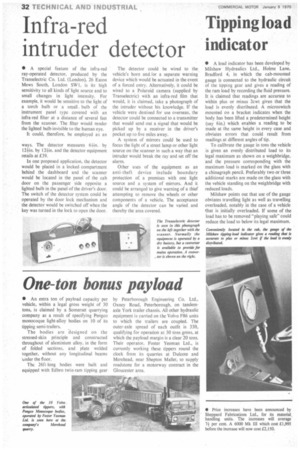Infra-red Tipping load intruder detector indicator
Page 38

If you've noticed an error in this article please click here to report it so we can fix it.
• A special feature of the infra-red ray-operated detector, produced by the Transelectric Co. Ltd. (London), 26 Eaton Mews South, London SW!, is its high sensitivity to all kinds of light source and to small changes in light intensity. For example, it would be sensitive to the light of a torch bulb or a small, bulb of the instrument panel type covered with an infra-red filter at a distance of several feet from the scanner. The filter would render the lighted bulb invisible to the human eye.
It could, therefore, be employed as an ways. The detector measures 6-i-in. by 12-i-in. by 1V7in. and the detector equipment retails at £39.
In one proposed application, the detector would be placed in a locked compartment behind the dashboard and the scanner would be located in the panel of the cab door on the passenger side opposite a lighted bulb in the panel of the driver's door. The switch of the detector system could be operated by the door lock mechanism and the detector would be switched off when the key was turned in the lock to open the door. The detector could be wired to the vehicle's horn and /or a separate warning device which would be actuated in the event of a forced entry. Alternatively, it could be wired to a Polaroid camera (supplied by Transelectric) with an infra-red film that would, it is claimed, take a photograph of the intruder without his knowledge. If the vehicle were destined for use overseas, the detector could be connected to a transmitter that would send out a signal that would be picked up by a receiver in the driver's pocket up to five miles away.
A system of mirrors could be used to focus the light of a street lamp or other light source on the scanner in such a way that an intruder would break the ray and set off the alarm.
Other uses of the equipment as an anti-theft device include boundary protection of a premises with one light source and a system of mirrors. And it could be arranged to give warning of a thief attempting to remove the wheels or other components of a vehicle. The acceptance angle of the detector can be varied and thereby the area covered. • A load indicator has been developed by Milshaw Hydraulics Ltd., Holme Lane, Bradford 4, in which the cab-mounted gauge is connected to the hydraulic circuit of the tipping gear and gives a reading of the ram load by recording the fluid pressure. It is claimed that readings are accurate to within plus or minus 2cwt given that the load is evenly distributed. A microswitch mounted on a bracket indicates when the body has been lifted a predetermined height (say bin.) which enables a reading to be made at the same height in every case and obviates errors that could result from readings at different angles of tip.
To calibrate the gauge in tons the vehicle is given an evenly distributed load to its legal maximum as shown on a weighbridge, and the pressure corresponding with the maximum load is marked on the glass with a chinagraph pencil. Preferably two or three additional marks are made on the glass with the vehicle standing on the weighbridge with reduced loads.
Milshaw points out that use of the gauge obviates travelling light as well as travelling overloaded, notably in the case of a vehicle 'that is initially overloaded. If some of the load has to be removed "playing safe" could reduce the load to below its legal maximum.








































































































